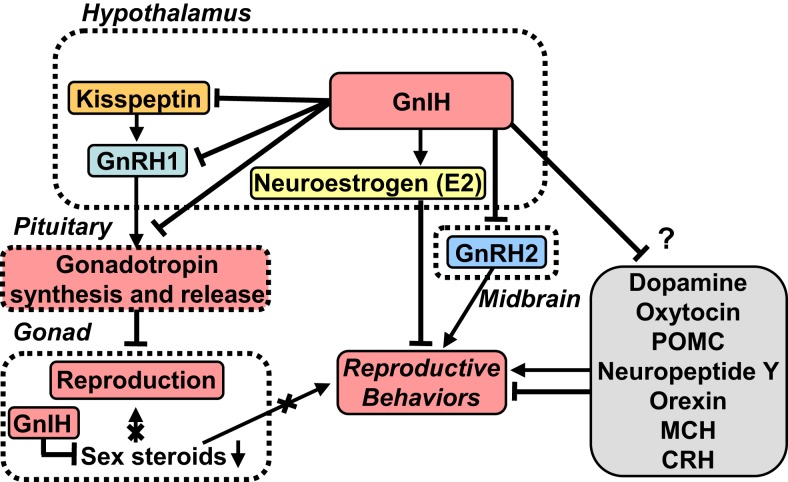Figure 1.
A schematic model of GnIH actions on the regulation of reproduction and reproductive behaviors. GnIH is a newly discovered hypothalamic neuropeptide that inhibits gonadotropin release in the quail brain (18). GnIH is highly conserved among vertebrates. GnIH acts as a key player in the regulation of reproduction and reproductive behaviors across vertebrates. Cell bodies for GnIH neurons are localized in the paraventricular nucleus (PVN) in birds and in the dorsomedial hypothalamic area (DMH) in mammals. Terminals from GnIH neurons are localized to the median eminence (ME) and GnRH1 neurons in the preoptic area (POA) in birds and mammals. GnIH receptor is expressed in gonadotropes in the pituitary and GnRH1 neurons in the POA in birds and mammals. Thus, GnIH inhibits gonadotropin synthesis and release by directly acting on gonadotropes in the pituitary and by inhibiting the activity of GnRH1 neurons in the POA via GnIH receptor in birds and mammals. GnIH neurons project not only to GnRH neurons but also to kisspeptin neurons in the hypothalamus in mammals. Kisspeptin neurons express GnIH receptor in mammals. GnIH and GnIH receptor are also expressed in steroidogenic cells and germ cells in gonads, and GnIH possibly acts in an autocrine/paracrine manner to suppress gonadal steroid production and germ cell differentiation and maturation in birds and mammals. GnIH participates not only in neuroendocrine functions but also in behavioral control in birds and mammals. GnIH inhibits reproductive behaviors, such as sexual and aggressive behaviors, and stimulates feeding behavior by acting within the brains of birds and mammals. Furthermore, GnIH inhibits reproductive behaviors by changing the biosynthesis of neuroestrogen (E2) in the POA. GnIH neurons further project to many other neurons in the brain suggesting multiple actions of GnIH. See the text for details.

